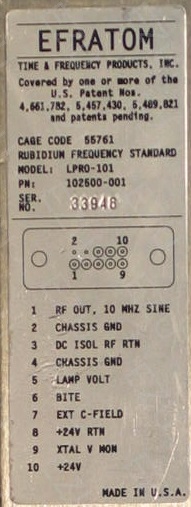
It is always a good idea to test surplus gear, before trying to mount it in a box. This unit can be tested without a heat sink for periods up to 30 minutes. So I started by making a very simple loom to connect power, monitor the BITE and LAMP VOLT outputs and feed the RF output into my spectrum analyser. Thankfully there is a label on the side of the unit that has all of the information that we need to wire it up.
When powered from cold the unit draws 1.2A at 24V, it heats up for 1-2 minutes and then the current begins to drop. Once unit has warmed up (keeping in mind the Rb chamber is +106degC) the unit will achieve atomic lock and the BITE output drops to zero. Once the unit has reached thermal equilibrium the current drawn falls back to 0.4A or there about.
It should be no surprise that the output of the module was measured at +7dBm and that the frequency was bang on 10.0000MHz which is the limit of my Spectrum analyser internal resolution.
The LAMP VOLT output requires a special mention since it can be used to estimate the remaining life within the physics engine. As the Rubidium lamp ages it’s output level drops until eventually the unit can no longer achieve atomic lock. A good or healthy Efratom LPRO-101 should output between 6-9V, below 3V they do not lock. The unit I have outputs 4.6V, so it is definitely used and perhaps a few years of continuous use away from the end of it’s life. So used sparingly it should certainly last me a good many years. I will however be out looking for a spare in case I need a replacement, time to hit Ebay.
There are two very good repair guides available on the internet that are not hard to find;
- “Erfratom LPRO-101 Repair Reference Guide” – Fred de Vries PE1FBO
- “Efratom Model FRS-C 10MHz Rubidium Clock” – Gerald Molenkamp VK3FGJM
I cant thank both authors enough for sharing their experiences with repairing these units. Once I obtain another unit I may very well be confident to attempt repairing one of my units and “refurbishing” the Rb lamp.
